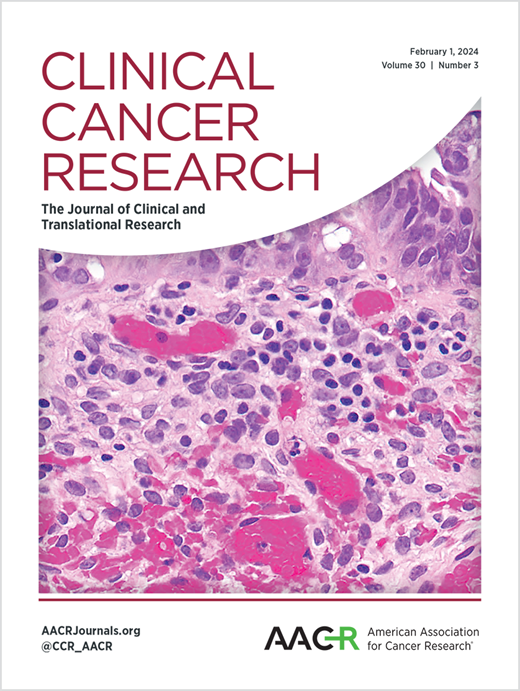桥接疗法后的代谢肿瘤体积反应决定嵌合抗原受体T细胞治疗大B细胞淋巴瘤的效果
IF 10
1区 医学
Q1 ONCOLOGY
引用次数: 0
摘要
目的:疾病负担加重是嵌合抗原受体 T 细胞疗法(CART)疗效较差的一个公认预测因素。虽然桥接疗法(BT)被广泛应用于白细胞清除术和 CAR T 细胞输注之间,但评估桥接疗法对 CART 治疗效果影响的数据却很有限。在本研究中,我们假设桥接治疗期间放射性细胞减少的定量动态变化对预后有影响。患者和方法纳入2016-2022年间接受CD19-CART治疗的大B细胞淋巴瘤(LBCL)患者。所有患者的代谢肿瘤体积(MTV)均在白细胞清除前PET上测定,接受BT的患者则在BT后/灌注前PET上测定。根据无进展生存期(PFS)最大选择对数秩统计法确定的MTV切点为65.4cc,将患者分为 "高 "和 "低 "疾病负担。结果在接受 CART 治疗的 191 名患者中,144 人(75%)接受了 BT 治疗。在 BT 组中,56% 的患者在 BT 后 MTV 有所下降。多变量分析显示,桥接期的MTV轨迹仍与PFS显著相关(p<0.001),但与最初和持续低MTV(低->低)患者相比,MTV改善(高->低)患者的PFS明显相当(高->低MTV的HR:2.74,CI:0.82-9.18)。与高>高相比,高>低 MTV 组群中任何等级的 ICANS 均有所减少(13% 对 41%,P=0.05)。结论:这是第一项利用放射组学量化大规模真实世界低密度脂蛋白胆管癌队列中BT前后疾病负担的研究。我们证明,有效的 BT 可以使最初疾病负担较重的患者获得与疾病负担较轻的患者相当的 CART 后疗效。本文章由计算机程序翻译,如有差异,请以英文原文为准。
Metabolic tumor volume response after bridging therapy determines chimeric antigen receptor T-cell outcomes in large B cell lymphoma
Purpose: Greater disease burden is a well-established predictor of poorer outcomes following chimeric antigen receptor T-cell therapy (CART). While bridging therapy (BT) is widely used between leukapheresis and CAR T infusion, limited data has evaluated the impact of BT on CART outcomes. In this study, we hypothesized that the quantitative dynamics of radiomic cytoreduction during bridging are prognostic. Patients and Methods: Patients with large B-cell lymphoma (LBCL) treated with CD19-CART from 2016-2022 were included. Metabolic tumor volume (MTV) was determined for all patients on pre-leukapheresis PET and on post-BT/pre-infusion PET in those who received BT. Patients were stratified into ‘High’ and ‘Low’ disease burden using an MTV cutpoint of 65.4cc established by maximally selected log-rank statistic for progression free survival (PFS). Results: Of 191 patients treated with CART, 144 (75%) received BT. In the BT cohort, 56% had any reduction in MTV post-BT. On multivariate analysis, MTV trajectory across the bridging period remained significantly associated with PFS (p<0.001), however notably patients with improved MTV (High->Low) had equivalent PFS compared to those with initially and persistently low MTV (Low->Low) (HR for High->Low MTV: 2.74, CI: 0.82-9.18). There was a reduction in any Grade ICANS in the High->Low MTV cohort as compared to High->High (13 vs. 41%, p=0.05). Conclusions: This is the first study to use radiomics to quantify disease burden pre- and post-BT in a large real world LBCL cohort. We demonstrate that effective BT can enable initially high-disease burden patients to achieve post-CART outcomes comparable to low-disease burden patients.
求助全文
通过发布文献求助,成功后即可免费获取论文全文。
去求助
来源期刊

Clinical Cancer Research
医学-肿瘤学
CiteScore
20.10
自引率
1.70%
发文量
1207
审稿时长
2.1 months
期刊介绍:
Clinical Cancer Research is a journal focusing on groundbreaking research in cancer, specifically in the areas where the laboratory and the clinic intersect. Our primary interest lies in clinical trials that investigate novel treatments, accompanied by research on pharmacology, molecular alterations, and biomarkers that can predict response or resistance to these treatments. Furthermore, we prioritize laboratory and animal studies that explore new drugs and targeted agents with the potential to advance to clinical trials. We also encourage research on targetable mechanisms of cancer development, progression, and metastasis.
 求助内容:
求助内容: 应助结果提醒方式:
应助结果提醒方式:


